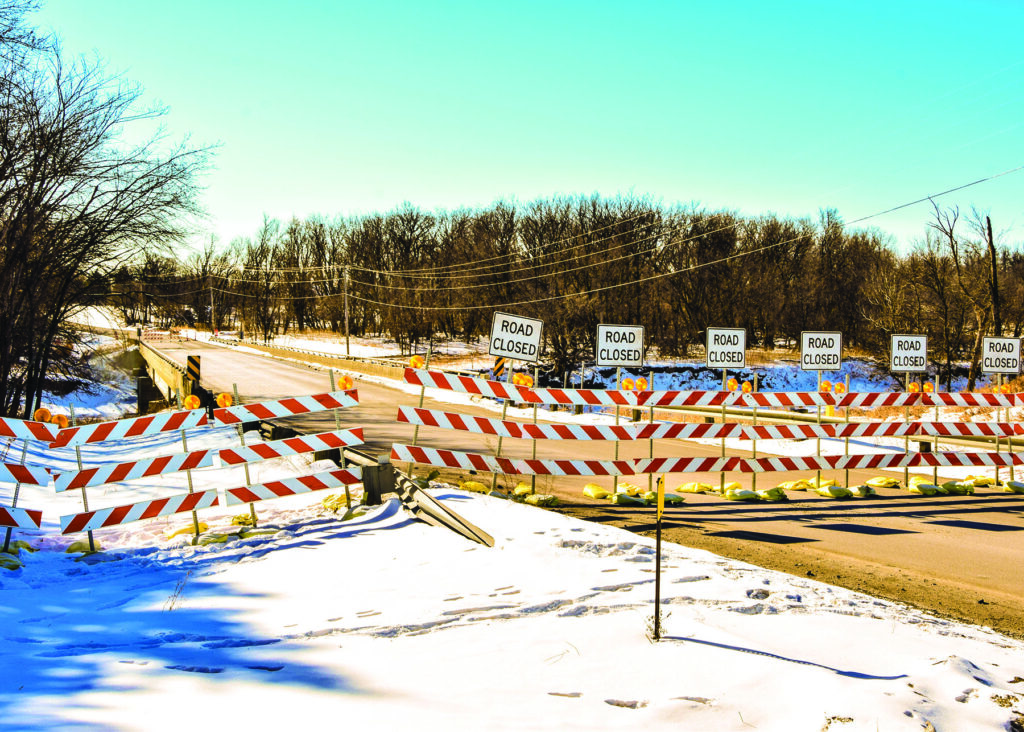
The North Broadway bridge across the Red River, built 30 years ago, has been closed due to shifting soil on the river bank. Photo/Russ Hanson.
Nancy Edmonds Hanson
That famous Red River Valley gumbo has struck again.
The North Broadway Bridge, which links the Fargo street to Wall Street/County Road 20 on the Minnesota side, has been closed to pedestrian traffic and the 1,500 or so vehicles that use it daily due to instability caused by its precarious position on the north bank of the river.
According to Clay County engineer David Overbo, the bridge – jointly owned and managed by the county and the city of Fargo – has been under close scrutiny for most of the years since its completion in 1990. Unlike most other bridges on the notoriously slippage-prone banks of the Red, this one was built with single rather than double rows of pilings – each sunk 130 feet deep to reach bedrock beneath the heavy clay. It also lacks rocker bearings to accommodate slight movements.
“You know you’re going to have movement,” says, Overbo, who has headed the county engineering office for the past 16 years. “Our soil is absolutely terrible for building heavy structures.”
The typical lifespan of a bridge, he says, is 75 to 100 years. Yet the Broadway bridge has been raising eyebrows since shortly after it was completed 30 years ago. Slight tippage was detected as early as 1992, spurring a project to stabilize the north pier. “That stopped it for awhile. But then soil pressure on the bottom of the pier continued to tip it toward the river,” he notes.
Clay County engineering staffers have been monitoring the progress of the tilt for 20 years. In 2018, as part of a study to assess options for fixing the structure, it was recommended to monitor the bridge monthly. After the first reading, it was determined that weekly monitoring would be necessary. The two states’ departments of transportation also perform annual inspections, as they do on the Red River bridges up and down the valley.
“The tilt had been very gradual for 18 months,” Overbo says. “But the latest measurements showed that the east side of the north pier had begun tipping quicker, essentially catching up with the movement on the west side of the pier. The tilt angle was close to the threshold for closure.” Thus, in a meeting last week, the county, city and state representatives decided to close it indefinitely while solutions are assessed: “At this point it isn’t going to get any better.”
The Clay County engineer says a decision will be made in coming months between three options. One is to repair the bridge; another is to replace it. The cost of either choice, he suggests, could be between $2 and $4 million.
The third option? “Removal with no replacement,” he says. “But some members of the public are not going to be happy.” In the meantime, traffic is being directed to more heavily traveled Wall Street/ County 20 crossing just a quarter mile west of the troubled bridge, which already carries four times as much traffic.
Despite its lower traffic count, the Broadway bridge is among the most heavily traveled in Clay County’s portfolio of 248 bridges and 750 miles of roads. (The engineers also supervise some 200 crossings over box culverts on rural roadways.) Most of the department’s funding comes from the Minnesota gas tax, of which Clay County shares 29 cents of every dollar with Minnesota’s other 86 counties. In addition to the gas tax funds, Minnesota funds bridge replacements with bridge bond funds in the amount of $40 to $100 million per biennium.
The cost of repairing or replacing the Broadway bridge, like its ownership, would be shared equally by Clay County and the City of Fargo.


